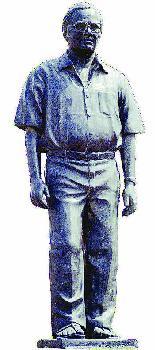Archivo:Rachakonda Viswanatha sastry.jpg
Este archivo es de Wikimedia Commons y puede usarse en otros proyectos. La descripción en su página de descripción del archivo se muestra debajo.
Resumen
| DescripciónRachakonda Viswanatha sastry.jpg |
English: "The courts, the police and the laws are being increasingly used to protect the affluent making a mockery of democracy. Justice is being crushed by the greedy men in black coats and the lathis of the khakis (cops), taking advantage of the loopholes in the laws," wrote Rachakonda Viswanatha Sastry, popularly known as Raavi Sastry, a lawyer, a writer and above all, a great humanist who wanted to improve the conditions of the poor through his writings.
Himself being a flourishing lawyer did not deter him from deriding his own clan that way. His novels reflect the problems of the common man. As a lawyer he used to empathise with the feelings of his clients. He sympathised with the villagers, who used to knocks at the courts for justice. He drew a parallel between villagers going to the cities with a lamb going to the forests for grazing. "Labourers and agriculturists should protect their own interests. They should not tolerate oppression, failing which they would continue to be harassed. When the rulers turn into Hiranyakashipa (the demon king who harassed his subjects), the people should don the role of Lord Narasimha," he advised the common folk. Born to Narayana Murthy and Sitalakshmi at Srikakulam on July 20, 1922, Sastry shifted to his native village Tummapala, near Anakapalle. His father was a lawyer and mother a litterateur. He did his B.A.(Honours) in philosophy from Andhra University and B.L. from the Madras Law College in 1946. He learnt the basics of the legal profession from his senior Lawyer Taata Sri Ram Murthy in 1948 and started his own practice in 1950. Though he was a staunch Congressman in the beginning, he was influenced by Marxism in the 1960s. "Raavi Sastry's profession is law: his philosophy is to root out the same law that perpetuates oppression, etc," says A. Prasanna Kumar in his book "Celebrities All". Beginning with his novel "Alpajeevi" in 1953, he wrote seven novels. The other novels include "Illu", "Ratthalu Rambabu" and "Raju - Mahishi". He wrote his first short story in his house at Thummapala in 1936. At a meeting of the Visakha Writers Association in 1963, he called upon the participants to do some introspection on their writings. He was elected vice-president of Virasam (Revolutionary Writers' Association)in 1970. Sastry was influenced by the writings of Lamb and Dickens and inspired by the writings of Gurazada Appa Rao and Sri Sri. He wrote the dialogues for the film "Stree" and the screen play for the Hindi film "Raja Aur Rank" between 1969 and 1971. He had a subtle sense of humour. Whenever his friends asked him, "Sastry, shall we party today to celebrate the occasion?", he would reply, "Where is the need for a special occasion, we have been `sitting' at the bar daily either on the plea that we are sad, overjoyed, lost a case or won a case." His fondness for Yarada hill is well known. "Visakhapatnam would not have had a port, if there is no Yarada Konda. If there were no port, the city would not have attracted so many industries. In the absence of industries, there would have been no jobs. That is why, I like the Yarada Konda in my city", Rachakonda used to say. Though the guiding light is no more, Sastry's writings will continue to inspire the people for several generations to come. The statue of this revolutionary writer is located on the Beach Road. |
| Fecha | |
| Fuente | Trabajo propio |
| Autor | R anirudh |
Licencia
- Eres libre:
- de compartir – de copiar, distribuir y transmitir el trabajo
- de remezclar – de adaptar el trabajo
- Bajo las siguientes condiciones:
- atribución – Debes otorgar el crédito correspondiente, proporcionar un enlace a la licencia e indicar si realizaste algún cambio. Puedes hacerlo de cualquier manera razonable pero no de manera que sugiera que el licenciante te respalda a ti o al uso que hagas del trabajo.
- compartir igual – En caso de mezclar, transformar o modificar este trabajo, deberás distribuir el trabajo resultante bajo la misma licencia o una compatible como el original.

|
Se autoriza la copia, distribución y modificación de este documento bajo los términos de la licencia de documentación libre GNU, versión 1.2 o cualquier otra que posteriormente publique la Fundación para el Software Libre; sin secciones invariables, textos de portada, ni textos de contraportada. Se incluye una copia de la dicha licencia en la sección titulada Licencia de Documentación Libre GNU.http://www.gnu.org/copyleft/fdl.htmlGFDLGNU Free Documentation Licensetruetrue |
Esta imagen es borrosa. Por lo tanto, podría calificar para su eliminación si se proporciona una imagen idéntica de mejor calidad.
Algunas imágenes pueden ser borrosas intencionalmente; estas no deben ser borradas y deben ser colocadas en Category:Intentionally blurred images. |
Leyendas
Elementos representados en este archivo
representa a
Algún valor sin elemento de Wikidata
24 ene 2009
Historial del archivo
Haz clic sobre una fecha/hora para ver el archivo a esa fecha.
| Fecha y hora | Miniatura | Dimensiones | Usuario | Comentario | |
|---|---|---|---|---|---|
| actual | 23:54 23 ene 2009 |  | 155 × 350 (14 KB) | R anirudh | {{Information |Description={{en|1= "The courts, the police and the laws are being increasingly used to protect the affluent making a mockery of democracy. Justice is being crushed by the greedy men in black coats and the lathis of the khakis (cops), taki |
Usos del archivo
Las siguientes páginas enlazan a este archivo:
